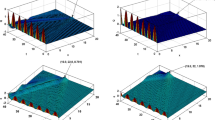Abstract
In the present study, the electrical network simulation method is proposed to solve the hyperbolic and parabolic heat conduction problem considering Cattaneo-Vernoute (C.V) constitutive relation. Using this new proposed numerical model and the electrical circuit simulation program HSPICE, transient temperature and heat flux profiles at slab can be obtained easily and quickly. To verify the proposed method, the obtained numerical results for cases of one dimensional two-layer slab under periodic boundary temperature with perfect and imperfect thermal contact are compared with the published results. Comparisons show the proposed technique might be considered as a useful tool in the analysis of parabolic and hyperbolic thermal problems.
Similar content being viewed by others
References
C. Cattaneo, A form of heat conduction equation which eliminates the paradox of instantaneous propagation, Compte Rendu, 247 (1958) 3.
P. Vernotte, Some possible complications in the phenomena of thermal conduction, Compte Rendu, 252 (1961) 2.
C. Wülbrich, Exact electric analogy to the vernotte hypothesis, physical review, 123 (1961) 2.
J. I. Frankel et al., General formulation and analysis of hyperbolic heat conduction in composite media, International Journal of Heat and Mass Transfer, 30 (1987) 1293–1305.
K. Ramadan, Treatment of the interfacial temperature jump condition with non-Fourier heat conduction effects, International Communications in Heat and Mass Transfer, 35 (2008) 1177–1182.
K.-C. Liu, Analysis of dual-phase-lag thermal behaviour in layered films with temperature-dependent interface thermal resistance, Journal of Physics D: Applied Physics, 38 (2005) 3722–3732.
A. F. Khadrawi et al., Thermal behavior of perfect and imperfect contact composite slabs under the effect of the hyperbolic heat conduction model, International Journal of Thermophysics, 23 (2002) 581–598.
Y. M. Lee and T. W. Tsai, Ultra-fast pulse-laser heating on a two-layered semi-infinite material with interfacial contact conductance, International Communications in Heat and Mass Transfer, 34 (2007) 45–51.
M. A. Al-Nimr et al., Thermal behavior of a multi-layered thin slab carrying periodic signals under the effect of the dual-phase-lag heat conduction model, International Journal of Thermophysics, 25 (2004) 949–966.
H. Ahmadikia et al., Analytical solution of non-Fourier and Fourier bioheat transfer analysis during laser irradiation of skin tissue, Journal of Mechanical Science and Technology, 26 (2012) 1937–1947, 2012/06/01.
H. Ahmadikia and M. Rismanian, Analytical solution of non-Fourier heat conduction problem on a fin under periodic boundary conditions, Journal of Mechanical Science and Technology, 25 (2011) 2919–2926, 2011/11/01.
M. A. Al-Nimr et al., A generalized thermal boundary condition for the hyperbolic heat conduction model, Heat and Mass Transfer, 39 (2002) 69–79, 2002/11/01.
M. A. Al-Nimr and O. M. Haddad, The phase-lag concept in the thermal behavior of lumped systems, Heat and Mass Transfer.
M. A. Al-Nimr et al., Effect of thermal losses on the microscopic hyperbolic heat conduction model, Heat and Mass Transfer/Waerme- und Stoffuebertragung, 39 (2003) 201–207.
M. A. Al-Nimr et al., Heat transfer mechanisms during short-pulse laser heating of two-layer composite thin films, Heat and Mass Transfer, 38 (2002) 609–614.
S. Kiwan et al., Trial solution methods to solve the hyperbolic heat conduction equation, International Communications in Heat and Mass Transfer, 27 (2000) 865–876.
F. Alhama et al., An efficient method for simultaneously determining thermal conductivity and specific heat in solids in the form of an inverse problem, International Communications in Heat and Mass Transfer, 31 (2004) 929–937.
J. Z. Jordán, Network method to study the transient heat transfer problem in a vertical channel with viscous dissipation, International Communications in Heat and Mass Transfer, 33 (2006) 1079–1087.
F. Alhama et al., Numerical solution of the heat conduction equation with the electro-thermal analogy and the code PSPICE, Appl Mathematics and Computation, 162 (2005) 103–113.
C. F. González-Fernández and F. Alhama, Heat transfer and the network simulation method, in network simulation method, Research Signpost, Trivandrum-695023. Kerala (India) (2002).
L. W. Nagel, in SPICE, a Computer Program to Simulate Semiconductor Circuits, ed University of California (1973).
Author information
Authors and Affiliations
Corresponding author
Additional information
Recommended by Associate Editor Yang Na
Amir Mirza Gheitaghy received his B.Sc. degree from Ferdowsi University of Mashhad, Iran, in 2009. He then received his M.Sc. in Iran University of Science and Technology (IUST) of Tehran and is currently working toward a PhD there. His research concerns thermal science and fluid dynamics.
Mohammad Reza Talaee is a Professor Assistant of Railway School, Rolling stock, Iran University of Science and Technology (IUST), Tehran, Iran. He received his Ph.D. degree in Mechanical Engineering from IUST on solving non-Fourier heat conduction equation. His research area concerns heat transfer and Aerodynamics.
Rights and permissions
About this article
Cite this article
Gheitaghy, A.M., Talaee, M.R. Solving hyperbolic heat conduction using electrical simulation. J Mech Sci Technol 27, 3885–3891 (2013). https://doi.org/10.1007/s12206-013-0933-x
Received:
Revised:
Accepted:
Published:
Issue Date:
DOI: https://doi.org/10.1007/s12206-013-0933-x



